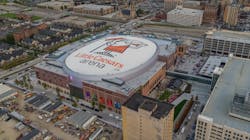Some say being in the right place at the right time is pure luck; others say it is usually by design. When an integrator wins a project that results in the company quadrupling in size, it is hard to dispute that the integrator was indeed in the right place at the right time.
Such was the case for Identify Inc., an integrator headquartered in Madison Heights, Mich., which leveraged a strong relationship to unexpectedly win a bid on the full security systems for Little Caesars Arena – the dazzling new home of the NHL’s Detroit Red Wings and the NBA’s Detroit Pistons, and the crown jewel of the reborn “District Detroit” in the city’s downtown area that has seen more than 200 new development projects.
The project – named this year’s Elliot A. Boxerbaum Memorial Award winner for security project of the year – was also the catalyst for Identify Inc.’s explosive growth; in fact, the company has played a vital role in the rebirth of downtown Detroit by spearheading security not only for the new Arena, but also for neighboring facilities including Little Caesars Global Resource Center & Headquarters, The Henry Ford Museum and the Ilitch Holdings Command Center. “I always thought of us as a kind of smaller company that does big things,” says Robert Suszynski, who, along with partners Tom Mezza and John Rademaker, launched Identify Inc., just eight years ago in 2010.
The expansive Little Caesars Arena and the “District Detroit” surrounding area is a 50-city block development encompassing world-class sports and entertainment facilities, six theaters and performing arts centers in addition to five neighborhoods. Consulting engineering firm DVS, a division of Ross & Baruzzini, worked closely with Identify Inc., and client Olympia Development of Michigan. In the area around Little Caesars Arena, more than $18 million has been invested in the city’s infrastructure, including blocks of landscaped medians which both beautify the area and provide traffic control and security benefits.
The project was the unanimous pick of the Boxerbaum Award’s selection committee (comprised of a panel of security industry professionals) based on its intricate scope of work, flexibility to project changes, advanced technology and security solutions, maintaining a secured vision with an eye towards design and aesthetics and compliance to strict DHS-certification requirements.
The award is named for the late Elliot A. Boxerbaum, MA, CPP, CSC, founder and president of Security Risk Management Consultants, who passed away in June 2014 from ALS. The award presentation was made on Nov. 6, 2018, at the CONSULT Technical Security Symposium in Nashville.
From Pizza to Sports Arenas
From nearly the beginning, Rademaker, Mezza and Suszynski – all veterans of the security industry – leveraged a key relationship with one of the big players in the Detroit area, Ilitch Holdings, which started way back in 1959 when Mike and Marian Ilitch opened the first Little Caesars pizza restaurant in the Detroit suburbs. Ilitch Holdings grew exponentially from there, with the Little Caesars franchises serving as a launching point for the purchase of the NHL’s Detroit Red Wings (1982), Olympia Stadium Corp. (1982), The Fox Theater in Downtown Detroit (1987) and the MLB’s Detroit Tigers (1992).
What began as a local security integrator retrofitting, upgrading and outfitting Little Caesars franchise locations quickly blossomed into a long-term relationship for the Identify team. Identify was eventually tasked with securing all franchise locations, as well as Blueline Food Distribution locations, which supplies each of the franchises with ingredients and other necessities.
As the Ilitch Holdings security integrator of record, it put Identify Inc. in the position of winning some larger projects. The first was at Comerica Park, the home of the Detroit Tigers, where Identify oversaw security upgrades for the stadium and its parking facilities. That seemed to open the floodgates.
“We are (Ilitch Holdings’) integrator of record, and it just so happened that they were going to be building an arena,” Suszynski says. “That doesn’t mean that we were just handed the job – typically companies of our size don't get big projects like that. In the beginning, we were looking for other larger companies to team up with, but we actually were able to have the opportunity to quote the business directly. We were able to successfully win the bid.”
The massive project meant Identify Inc., would need to expand quickly to meet the requirements of the project. “We probably quadrupled in size revenue-wise in just the last year – not just because of the one project, but because of the other projects in the district as well, which were being done simultaneously,” Susynski explains. “It was a huge undertaking; in fact, right before the arena project, we decided to go union. To work on big projects like that, where we are from, you want to be a union contractor.”
Olympia Development of Michigan and the city of Detroit banked on the selected location of the new Little Caesars Arena connecting the downtown Detroit business districts and Midtown by revitalizing dormant tracts of property that had been impacted by Interstate 75 slicing through it. That anticipated rejuvenation has occurred thanks to the arrival of the arena and the Mike Ilitch School of Business at Wayne State University.
The symbiotic relationship that has developed between the Little Caesars facility and the now vibrant District Detroit has opened up unimaginable entertainment, business and residential possibilities that would have been impossible earlier this decade. And when the NBA’s Pistons decided to move from the suburbs to downtown Detroit and into Little Caesars Arena, other major players followed suit like Google, which opened new offices adjacent to the arena.
The expanding footprint of the business community, initiated by the arena, took the security roadmap in an entirely different and complicated direction. According to Jeremy Zweeres, a Principal with DVS and the main project manager for this job, what had begun as a sports facility project quickly morphed into 50 city blocks of redevelopment – the largest of its kind taking place in an urban city environment in the United States.
“What was different from this arena from any other is that Ilitch Holdings, Olympia Development, and Olympia Entertainment really looked at this holistically not just as a singular project. This was the anchor of an entirely new project, which was the redevelopment of this new district,” Zweeres says.
Along with making plans for the arena, DVS also participated in the planning to provide and develop the engineering for 25 open parking lots and five official parking structures that surround the district area, which starts from Tigers Garage 2, which is directly adjacent to Comerica Park, stretching all the way out to the opposite end of the arena.
“Not only are you providing a great place for people to come, and enjoy, and go eat and have drinks, and share time with the family, but also providing them a safe environment for parking and how they get there,” Zweeres says. “As part of that, we put together this holistic security design so that in any one of those parking structures or open parking lots leading up to the arena, we have close to 100-percent video surveillance coverage of the patrons. It is really creating an overall safe environment off-site as well as on-site in order to maintain strict requirements that the client had as well as meeting all the NHL and NBA security requirements and recommendations.”
Secure Enough for DHS Certification
Rick Fenton, who had more than 27 years in law enforcement, joined Olympia Entertainment/Ilitch Holdings as Senior Director of Corporate Security 18 years ago and is currently VP of Corporate Security for Ilitch Holdings. He has seen the transformation of the Detroit District, beginning with the building of Comerica Park, and was instrumental in securing DHS/Safety Act Certification for that facility, and also following that DHS blueprint to achieve the same certification for Little Caesars Arena.
Fenton, the DVS team and Identify Inc., had to demonstrate and detail a threat/risk assessment analysis of the various redundant, resilient, physical and electronic security measures designed and installed to achieve the DHS designation. In the end, Little Caesars Arena became the first arena in the U.S. to earn DHS Safety Act Certification, which ensures liability protections of "Qualified Anti-Terrorism Technologies (QATTS)" that could save lives in the event of a terrorist attack.
“The (NHL and NBA) have a variety of requirements related to video surveillance camera technology and really get down into the weeds of looking at pixel quality, frame rate, storage, all those kinds of things,” Fenton explains. “They are also looking at the outer perimeter and the inner perimeter and the middle perimeter and having different layers of technology that ultimately are redundant, resilient and inter-operable.”
“They (DHS) just wants to make sure that you have done a very high-level of security diligence, because they are becoming an insurance broker for a terrorist event should something happen,” explains Jeffrey Venter, senior Principal at DVS. “DHS wants to know that they can go back and say, ‘this particular facility has really done a good job at every element of security.' That’s not just the design – it is also the vehicle interdiction, the screening of the people, the locations where all your different screening operations will take place –it is the security operations and staff that you have and the policies and procedures you put in place for all different types of events.
“This isn't just hockey or basketball,” Venter adds. They will have many other events; so, there are a lot of different things that must be taken into consideration. It is a big picture approach – looking at every different scenario to make sure that you have taken into the consideration today's threats and carefully ensuring that you put in mitigation – or decided not to for specific reasons – for every one of those elements.”
The distinction of the DHS Safety Act certification also requires that both Fenton and DVS continually strive for solutions that will keep their clients safe and secure. It’s a five-year certification, so DVS has developed a five-year plan to addresses tomorrow’s threats.
“At the end of the day, bad guys are always thinking of different ways to hit you,” Fenton says. “If you and I were having this conversation six to eight years ago, we would be talking about things much different than a guy going down to the corner rental place, renting a truck and vehicle-ramming people. The Safety Act actually requires you to look at the changing landscape and to continuously improve.”
Integrating Systems with Redundancy
Zweeres says the original design for the arena was intended to provide a fully integrated and fully unified security system, integrating access control, video surveillance, intrusion detection and intercom that are all software interoperable.
“Whether it is a four-story building tying the intercom on-site or even one of the emergency blue phones that are 10 city blocks down the road at a parking structure, being able to tie that back to get video verification or an alarm back into these security operations is a key thing,” Zweeres says. “Because they are a major stakeholder within the city, they also have other locations where we could act as secondary and even tertiary operation centers as a fall back. All the devices that go into the arena not only communicate within the security operations center and…secondary command center that we have within the facility, but they can also go off-site to their district-wide command center over at the Fox (Theater) and at their security operations center in Comerica Park.
Halfway into the project, the Pistons announced they would also use the arena, which caused the DVS and Identify teams to make a quick pivot. “Not only did we have to now meet NHL security requirements and recommendations, but we had to address any of the NBA-specific requirements as well,” Zweeres says. “It certainly impacted how we looked at certain areas for video surveillance coverage. Now we needed to consider the bench positioning (because) the NBA has strict requirements of video surveillance all the way down to the pixel densities that they have in front of the bench, and back of the bench and at an entry point.”
Adds Suszynski: “When we started the project, we were coordinating with the electrical contractors, the low-voltage data contractor, the general contractor, but a lot of the work that we did was condensed right towards the last four months because we had to wait for everything to get built. When it really came to crunch time – probably that last four months before opening, – it was all hands on deck; It was 7 days a week, 10- and 12-hour days. It was crazy.”
The Technology Equation
When it came to specifying technology for the project, DVS and Identify leveraged Suszynzki’s knowledge of Ilitch Holdings’ preferred manufacturers in past projects. “(Ilitch Holdings) was already an Avigilon user, so that was the primary product for the video,” Suszynski says. “They also decided to go with Avigilon's ACM.”
Stentofon was used as the intercom systems provider and DSC for intrusion detection. “Jeremy was instrumental in making sure that there was good coordination between the customers and the manufacturers and the integrator,” Suszynski says. “He already knew they wanted Avigilon, but I think he brought some other product mixes to the table, like Stentofon. We thought the sound quality of that intercom system was amazing, and those intercoms are also used for their blue-phone station.”
Fenton was also impressed with the apparent seamless effort both DVS and Identify pulled together the technology package on the arena itself, along with the exterior perimeter solutions. “One of the great things that DVS was able to do was bring vendors to the table who were demonstrating that integration plan ,” Fenton says. “I'm not plugging one vendor over another, but as an example, Avigilon, which is a major camera platform, also has an integration with their access control system. We have learned that not all access control systems seamlessly mesh with the video surveillance system.”
Other security product manufacturers on the project included: RGB Spectrum (video wall); Mercury Security (access control panels); HID Global (access card readers); Morpho (biometric finger readers); Life Safety Power (power supplies); Winsted (security room consoles); StoneLock (facial readers); Raytec (IR illuminators); and NEC (facial recognition).
While DVS and the architects were creating an aesthetically-pleasing structure, it was Fenton’s job to work with his consultants and integrators to forge the security foundation both inside and outside the facility. “Everybody wants a beautiful building, right? But I want it to be a beautiful building that is safe and secure,” Fenton says. “Our ownership, CEO and president said: ‘this building is going to be here for 25 years, and we want it to be beautiful – but we want our employees and the athletes and concert artists to be safe and secure, and that's our number one consideration.’ There's not a lot of owners and CEOs that take that approach.”
“There were a lot of moving parts,” Suszynski says. “It was almost a miracle how it all came together, but everyone pulled together as a team. It was a good mix – from the customer down to the consultant, to us as the integrator. Everyone had the same vision and really wanted to get this thing done right, with high quality and at a high standard.”
To learn more about the annual Elliot A. Boxerbaum Memorial Award, please visit http://securityspecifiers.com.
Paul Rothman is Editor-in-Chief of Security Dealer & Integrator (SD&I) magazine. Access the current issue, full archives and apply for a free subscription at www.secdealer.com.






